Toward a Concrete Utopia: Architecture in Yugoslavia, 1948-1980
Toward a Concrete Utopia: Architecture in Yugoslavia, 1948-1980, Museum of Modern Art, New York, July 15, 2018 –January, 13 2019
New York’s Museum of Modern Art (MoMA) recently provided a stage for a vital – and very much on-trend – examination of the brutalist, socialist architecture of the former Yugoslavia, exhibited under the title Toward a Concrete Utopia: Architecture in Yugoslavia, 1948-1980. Structured around a set of thematic and biographical sequences, this momentous survey of socialist architecture brought together more than 400 drawings, models, photographs and video installations from a wide range of private and institutional archives across the former Yugoslavia and beyond. In showcasing Yugoslavia’s socialist architecture as a defined and distinct phenomenon, Toward a Concrete Utopia makes an argument for architecture’s capacity to produce a shared sense of history and identity within a highly diverse, multiethnic society.
The history of Yugoslav socialist architecture has to date largely been absent from the discipline’s canon. As exhibition curators Vladimir Kulić and Martino Stierli argue in the accompanying catalog, architectural history has repeatedly failed to offer a proper evaluation of the achievements of this region, owing largely to a strong Western-centric bias entrenched both by Cold War discourse and the Orientalist positioning of the region as Europe’s “Other”. (Martino Stierli and Vladimir Kulić, “Introduction,” Toward a Concrete Utopia: Architecture in Yugoslavia 1948-1980 (New York: The Museum of Modern Art, 2018), p. 7.)
In seeking to address this situation, the curatorial duo saddled themselves with the ambitious task of documenting the accomplishments – and global reach – of Yugoslav socialist architecture and, in so doing, remapping the history of modern architecture.
The assembled works span the period between 1948, which marked a formal split between Yugoslavia and the Soviet bloc, and the death of long-time Yugoslav leader Josip Broz Tito in 1980. These were three decades of dynamic transformation, during which the country was able to successfully establish a unique international identity. In seeking to distinguish their own brand of socialism from that of the Soviet Union, Yugoslav leaders decentralized the economy and introduced a model of self-management, liberalized cultural and artistic life, and positioned the country as equidistant from the two Cold War superpowers by becoming a founding member of the Non-Aligned Movement in 1961. This “third way” would prove to be a position of privilege during the Cold War: after the death of Joseph Stalin and normalization of relations with the Soviet Union in 1955, Yugoslavia was able to work with both East and West – eating, as one EU diplomat would later describe it, “from both sides of the banquet table.”(Aida Hozić, “It Happened Elsewhere. Remembering 1989 in the Former Yugoslavia,” in Michael Bernhard and Jan Kubic eds., Twenty Years After Communism, Oxford Scholarship Online, 2014, p. 30.) While maintaining this international position was a fine balancing act, so was the process of managing the country’s complex internal dynamics. Founded under the slogan “brotherhood and unity,” Yugoslavia was a multinational federation held together by the notion that the national and the supranational could operate in concert within a socialist framework. With Tito’s death in 1980, the story goes, the delicate ideological structure underpinning this slogan would – like so much of the exhibition’s titular concrete – quickly begin to crumble.
The exhibition endeavors to capture the complex dynamic between collective and individual regional identities, and in doing so makes a strong case for Yugoslav architecture as a conceptually rounded practice grounded in this dynamic. This argument is underscored by the exhibition’s rhythmic transition between individual and collective, national and socialist, local and global. Emphasising this point, each of the four thematic sections – Modernization, Global Networks, Everyday Life and Identities – is interspersed with profiles of architects who either contributed to a specific area of architecture or had particular regional significance.
Towards a Concrete Utopia opens with the theme of modernization, as a series of post-World War II reconstruction pieces call attention to the incredible speed with which Yugoslavia transformed from an agrarian to an industrialized and urbanized society. The scope of this drive is captured at every level, from large-scale projects such as the Belgrade Master Plan (1949-50) or the South Adriatic Regional Plan (1968), to a series of individual museum, university and library buildings, sport and recreation facilities, hospitals, kindergartens and international fairgrounds – collectively the institutional infrastructure that supported the building of socialist life in Yugoslavia. Here the curators remind us that all identities are constructed – some in reinforced concrete.
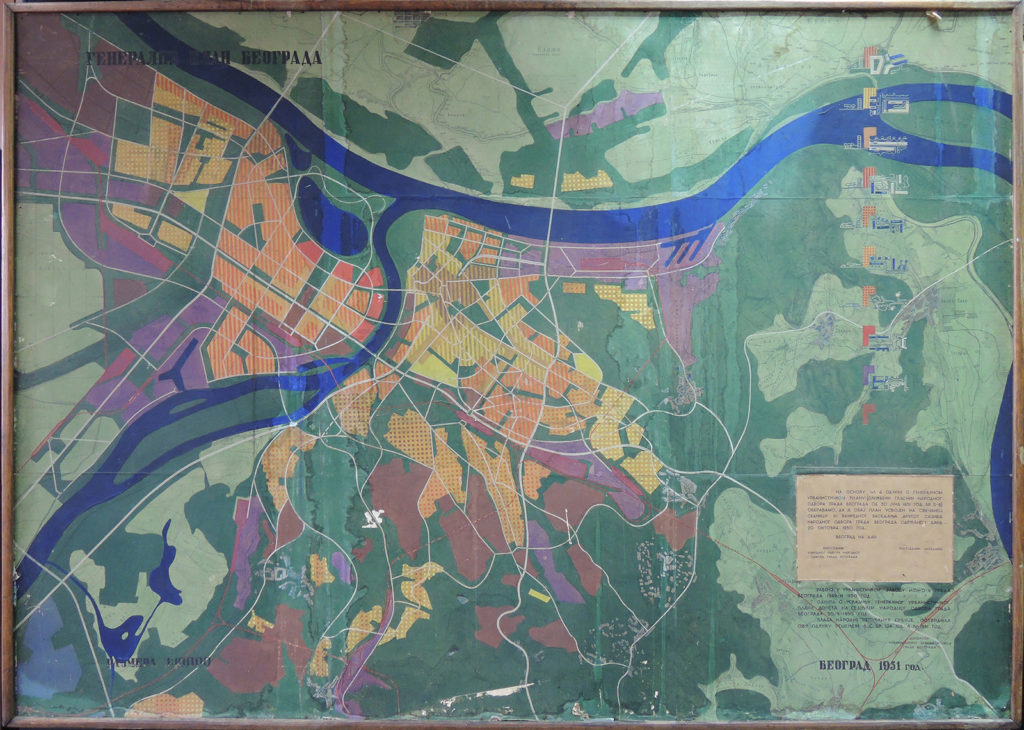
Urban Planning Institute of Belgrade, Belgrade Master Plan, 1949–50, Belgrade, Serbia, Plan 1:10000, 1951.
Within this opening section, Andrija Mutnjaković’s project for the National and University Library of Kosovo in Priština (1971-82) is a showstopper. The central element of the then newly-established University of Priština, this structure captures the spirit of socialist life-building as a force of emancipation and education, while honoring the local context by incorporating elements drawn from both Orthodox Christian and Muslim tradition. Cubic volumes and domes are repeated in a seemingly endless sequence, with aluminium filigree reminiscent of local craftsmanship covering the entire façade and lending a sense of coherence to the overall design. Mutnjaković’s building plays particularly well against an adjacent model for the Museum of Contemporary Art in Belgrade (1959) whose architects, Ivan Antić and Ivanka Raspopović, opted for a rhythmic repetition of six interconnected cubes. Though an imposing structure, the clear and restrained lines of this building (which has itself just re-opened, following a painstaking, decade-long restoration project) fuse harmoniously with the surrounding landscape. Founded by painter and art critic Miodrag B. Protić after his visit to New York (and specifically to MoMA) in 1962, the Museum represented a clear signal of the aspirations of the young country and its capital.

Andrija Mutnjaković, National and University Library of Kosovo, 1971–82. Priština, Kosovo. Exterior view. Photo: Valentin Jeck, commissioned by The Museum of Modern Art, 2016.
The fact that identity is both constructed and performed is underlined in Mila Turajlić’s video piece We Build the Country – The Country Builds Us! (2018). In assembling a series of clips from Yugoslav films and newsreels that focus on the performance of labor, Turajlić accentuates the centrality of the shared experience of the post-War reconstruction of Yugoslavia. Wide-spread (ostensibly voluntary) participation in so-called work actions (radne akcije) brought together people from all corners of the country, with the bonds formed through this shared endeavour serving as both the literal and metaphorical foundations for the new socialist country.
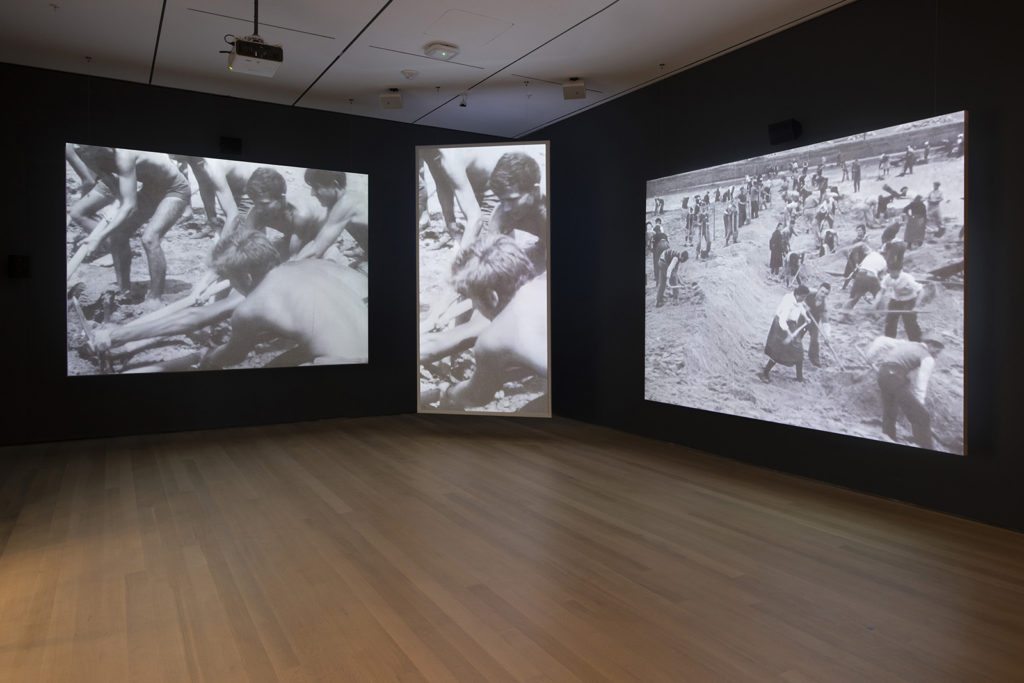
Mila Turajlić, “Mi gradimo zemlju – zemlja grad nas/We build the country – the country builds us!” 2018. Three-channel video. Installation view of Toward a Concrete Utopia: Architecture in Yugoslavia, 1948–1980, The Museum of Modern Art, New York, July 15, 2018–January 13, 2019. © 2018 The Museum of Modern Art. Photo: Martin Seck.
The ensuing section of the exhibition is dedicated to global networks, with Yugoslavia and its cities showcased as international hubs of activity and exchange. The reconstruction of Skopje following a devastating earthquake in 1963 is a prominent – and arguably the most captivating – feature here. With some 80 percent of the Macedonian capital having been destroyed, in 1964 the United Nations ran an international competition for a new master plan for Skopje; Japanese architect Kenzō Tange claimed victory, and with it an opportunity for Japanese architects to engage in a massive international project for the first time since World War II. While some elements were left unexecuted, many of those that were built would come to be recognized as paradigmatic examples of Yugoslav socialist architecture and its brutalist aesthetic. The Macedonian Opera and Ballet (1968-81), designed by a group of architects known as Biro 71, is a clear stand out here, with its cavernous structure and white-coated concrete appearing to rise majestically from the surrounding landscape in a dynamic upward swoop.
A small section dedicated to Belgrade-based construction company Energoprojekt examines another global trajectory, as socialist Yugoslavia during this time served also as a major exporter of architectural and building expertise. The country’s prominent position within the Non-Aligned Movement helped to forge an expansive network of economic and political ties, primarily to newly independent countries throughout Africa and Middle East, and Yugoslav enterprises found themselves with numerous opportunities to work on major development projects. In tracing the story of Energoprojekt’s global reach (and particularly the firm’s work in Nigeria), the exhibition focuses on Belgrade architect Milica Šterić – the first prominent Yugoslav female architect and founder of Energoprojekt’s architecture branch – who held leading roles within this enterprise both as an architect and also as a manager, designer and mentor. This story provides an opportunity to contemplate the common emancipatory impulse underpinning Yugoslav socialism and the contemporaneous processes of decolonisation that were at this time unfolding across the globe.
A survey of the tourist center architecture concludes this story of global connectivity. Images of hotels and resorts sourced from the archives of Turistkomerc – a Zagreb-based enterprise charged with promotion of Yugoslav tourist destinations – are here displayed on a looping slideshow reminiscent of holiday photos being displayed in a family living room (accompanied by blow-by-blow commentary). This intimate and nostalgic atmosphere cleverly sets the tone for the following section, which is dedicated to Yugoslav everyday life.
Here telephones, radios and folding chairs that filled so many Yugoslav homes are displayed adjacent stellar examples of Yugoslav mass-housing architecture, such as Dinko Kovačić and Mihajlo Zorić’s building block Split 3 (1970-79). Another video piece by Turajlić entitled Living Space/Loving Space (2018) suitably frames this space, with its collage of clips from iconic Yugoslav films that foreground the familiar (and romantic) dramas unfolding within these apartment blocks. While so many discussions of socialist housing architecture habitually focus on either its brutalist aesthetic or the anti-social behaviour associated with (or rather provoked by) life within these concrete mazes, the curatorial team here foregrounds a different dimension of this architecture – namely its highly experimental nature. Indeed, this is a red thread that runs throughout the exhibition: whether focus is trained on the design of a large-scale piece of public infrastructure, an opera house, a hotel, a mass-housing project or a monument, the spirit of experimentation is presented as a defining feature of this socialist architecture.

Dinko Kovačić and Mihajlo Zorić. Braće Borozan building block in Split 3. 1970–79. Split, Croatia. Exterior view. Photo: Valentin Jeck, commissioned by The Museum of Modern Art, 2016.
The concluding sections examine identities and are primarily organized around the profile architects Edvard Ravnakar, Juarj Neidhardt and Bogdan Bogdanović. As a federation of six republics and two autonomous provinces, Yugoslavia was a patchwork of different cultural identities and historical traditions; in the works displayed in this section, modernism serves as the framework through which architects sought to forge unity within this multiplicity. A display of drawings and illustrations from Neidhardt’s study Architecture of Bosnia and the Way to Modernity (1957) is a special highlight. Born in Zagreb, Neidhardt would eventually settle in Sarajevo where, in collaboration with his Slovenian colleague Dušan Grabrijan, he worked to produce this volume, in which he argued that Bosnia’s traditional architectural vernacular – its whitewashed walls, abstract cubic volumes, built-in furniture and large windows among others – was already in essence modernist, and could therefore serve as the basis for articulating the modern Yugoslavian architectural idiom. Intriguingly, these ideas echo concepts first developed by Yugoslavia’s interwar avant-garde, and primarily the Zenitist movement (1921-1926), whose members argued that the Balkan creative impulse – with its iconoclastic and irreverent bent and predilection for the idiosyncratic – was modernist avant la lettre and therefore an ideal basis for a new and progressive Yugoslav identity.
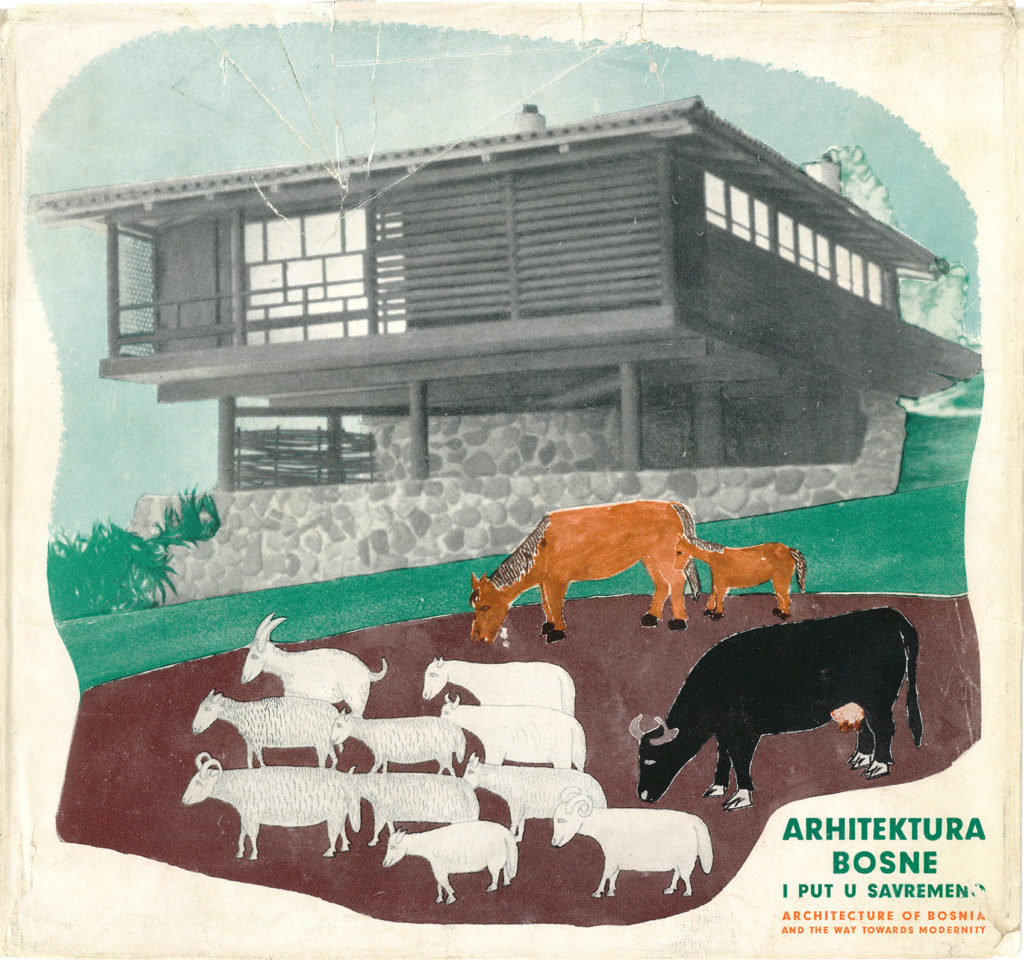
Dušan Grabrijan and Juraj Neidhardt, Cover of Architecture of Bosnia and the Way to Modernity, 1957. Private archive of Juraj Neidhardt.
The exhibition culminates with a striking examination of memorial architecture, featuring predominantly those monuments that were created to honor the victims of World War II. During the war, communist-led partisan forces fought not only against the fascist enemy, but also against a range of nationalist military groups that operated across the country. As one of the European countries that suffered the highest casualty rates, the wartime experience defined Yugoslavia as a country forged from the enormous sacrifice of its people. The war became a critical part of the country’s founding myth, creating a common sense of belonging to this victorious narrative was meant to heal divisions along national and ethnic lines. Accordingly, an examination on the work of Bogdan Bogdanović, who dominated the field of memorial architecture, grounds this section, which centers around a display of the plans for Bogdanović’s most well-known projects, including the Belgrade Monument to the Jewish Victims of Fascism (1951-52), the Jasenovac Memorial Site (1959-66), and the Shrine to the Fallen Serb and Albanian Partisans in Mitrovica (1960-73).
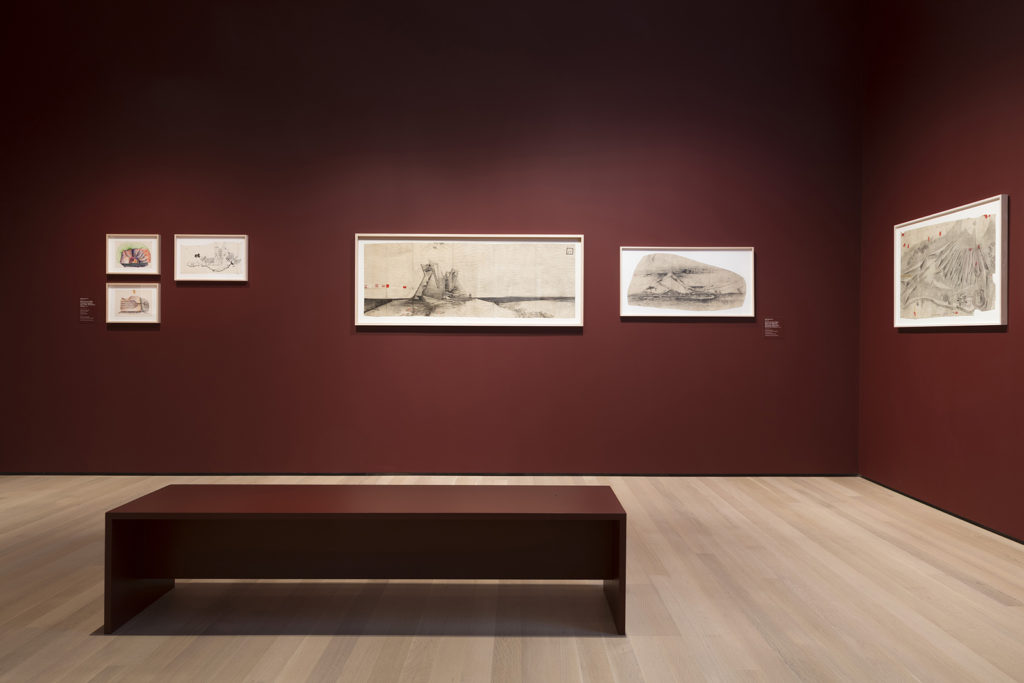
Sketches by Bogdan Bogdanović. Installation view of Toward a Concrete Utopia: Architecture in Yugoslavia, 1948–1980, The Museum of Modern Art, New York, July 15, 2018–January 13, 2019. © 2018 The Museum of Modern Art. Photo: Martin Seck.
Bogdanović’s interest in ethnography and Surrealist art, and his focus on the interplay between structure and the surrounding landscape underpin what is a unique rendering of memorial architecture, positioned equidistant from both the contemporary abstractionism and the socialist realism that had otherwise dominated this field. Indeed, the diversity and the experimental nature of Yugoslav memorial architecture is strongly represented throughout this section, with Miodrag Živković’s Monument to the Battle of the Sutjeska (1965-71), which commemorated a crucial partisan wartime victory, and Iskra and Jordan Grabul’s Monument to the Ilinden Uprising in Kruševo (1970-73), capturing attention as outstanding examples of the genre.
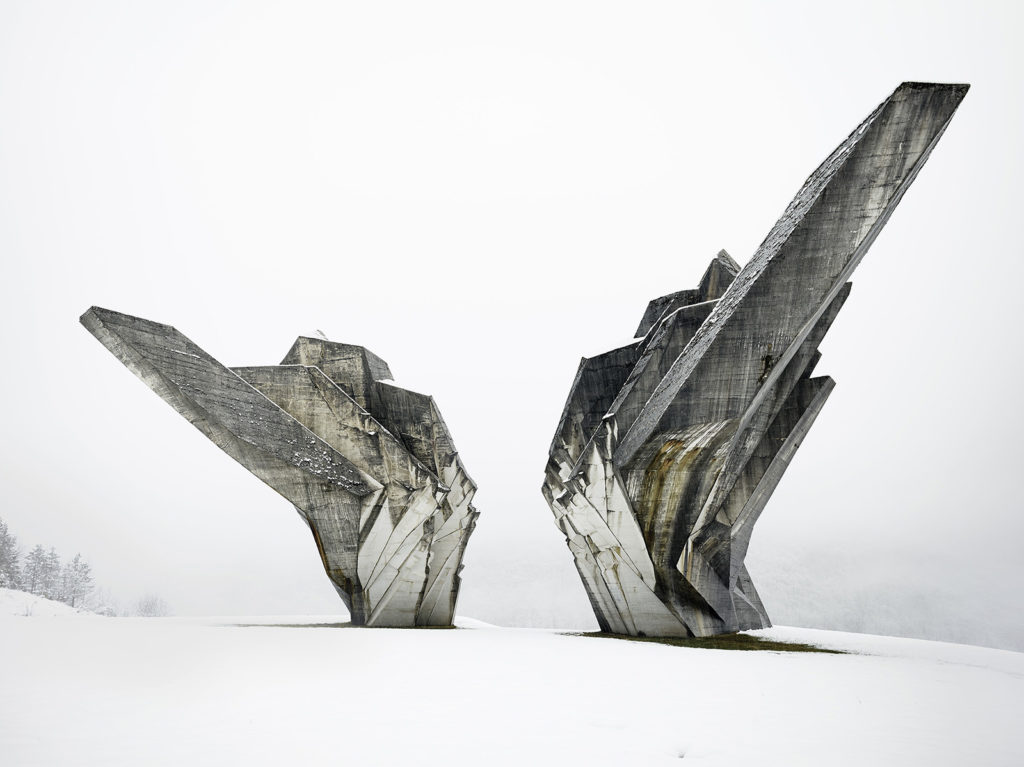
Miodrag Živković, Monument to the Battle of the Sutjeska, 1965–71, Tjentište, Bosnia and Herzegovina. Photo: Valentin Jeck, commissioned by The Museum of Modern Art, 2016.
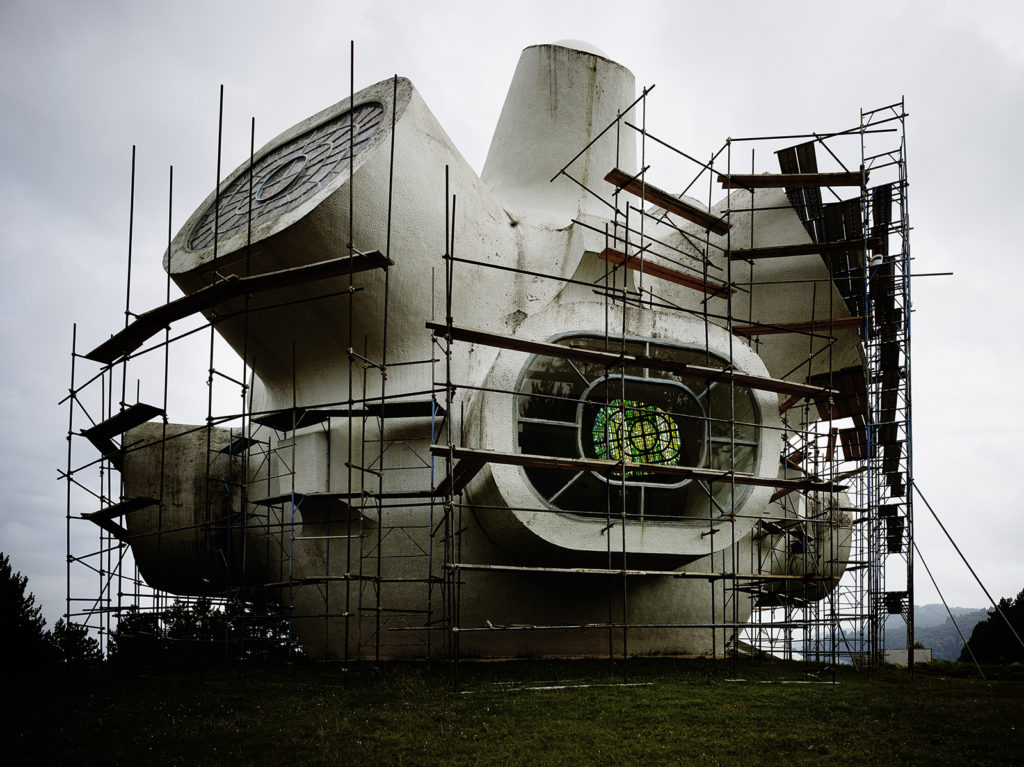
Jordan and Iskra Grabul, Monument to the Ilinden Uprising, 1970–73. Kruševo, Macedonia. Photo: Valentin Jeck, commissioned by The Museum of Modern Art, 2016.
Toward a Concrete Utopia does an excellent job of presenting a coherent story of Yugoslav socialist architecture in its full scale – from master plans to folding chairs – and within a global context that reaches from Nigeria to Japan. As a story, however, the exhibition has some blind spots. The decision to include architectural projects for Catholic cathedrals in Mostar and Podgorica and a mosque in Visoko without any reflection on the presence of religious architecture in a socialist country seems unusual. In addition, if one of the curatorial goals was to document the history of Yugoslav architecture, insight into the difficulties encountered in realizing the exhibition – which was assembled in a context in which successor regimes across the former Yugoslavia treat the socialist past with suspicion, and where efforts to preserve Yugoslav-era documentation have been undermined both by the wars of the 1990s and the privatization of state-owned enterprises – would surely have been telling. Ultimately, of course, only so much can be fit into a single exhibition.
Finally, a note on the choice for exhibition title: Toward a Concrete Utopia does not avoid the deeply-entrenched habit of associating any creative (or other) endeavour stemming from the socialist East with utopianism, which is a common feature of both academic and curatorial practice. The term utopia is often used without any theoretical consideration and applied simply as a synonym for something impossible and impractical – a beautiful dream that could never be – and therefore an endeavor doomed to failure. By applying this label, any notion that the world could be radically reimagined is cast into the realm of fantasy. In their essay for the exhibition catalog, however, Stierli and Kulić foreground an alternative definition of utopia – one grounded in a long philosophical tradition that differentiates between utopias that are indeed impractical and impossible from those that are grounded in reality and, while perhaps not realizable at the moment in time, have indeed a future potential for realization. Here they draw upon the work of philosopher Ernst Bloch who indeed insisted on the difference between “abstract” utopias – those that are fundamentally unrealizable – and a “concrete” utopia, which contains a future possibility and which the exhibition title playfully refers to.(Stierli and Kulić, “Introduction,” Toward a Concrete Utopia, p. 8; Ernst Bloch, The Principle of Hope, vols. 1-3 (Cambridge, MA: MIT Press, 1996, esp. 142-47.)
The conceptual shift that Stierli and Kulić make is important, as it represents a concerted effort to truly remap the history of this region. In contrast to the habitual labelling of socialist art (and architecture) as appealing but impractical, the curators insist that despite Yugoslavia’s failure as a political project, the ideas that underpin its architecture – architecture that serves the common good and celebrates an emancipatory drive – should not be dismissed as wishful thinking, because a radical reimagining of reality was, and is, possible.




